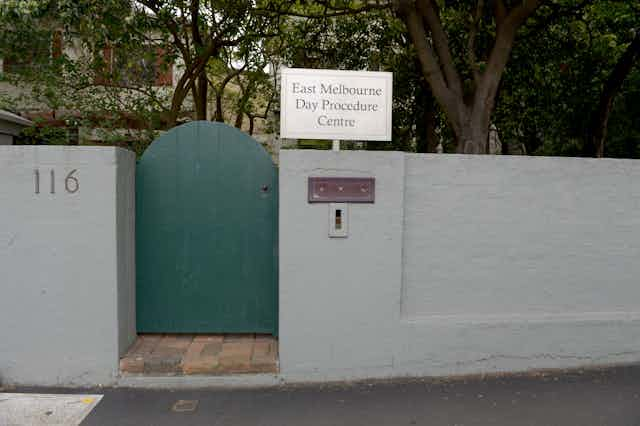It has been a significant few years for the legal promotion and protection of the right of Australian women to access the full range of reproductive health services. Legislation decriminalising abortion was passed in both Victoria and Tasmania. The federal government took a stance in support of the accessibility of RU486, the medical abortion pill.
And now, as of last week, three Australian jurisdictions have introduced “safe access zones” around abortion clinics.
How we got here
In 2008, Victoria decriminalised abortion. Following the legislation’s passage, abortion became legally available on request at up to 24 weeks gestation. However, practical availability remains a separate and challenging issue.
In 2012, at the federal level, RU486 – the drug required for a medical, as opposed to surgical, abortion – was included on the Australian Register of Therapeutic Goods. This decision meant RU486 could be prescribed in Australia by registered medical practitioners in general, as opposed to only those approved to prescribe the drug through the authorised prescriber process.
It was not until June 2013, though, that RU486 was finally included in the Pharmaceutical Benefits Scheme. This made it more affordable.
Drawing on Victoria’s 2008 abortion law reforms, towards the end of 2013 Tasmania decriminalised abortion and became the first Australian jurisdiction to introduce safe access zones. These are also sometimes referred to as “buffer zones” or “bubble zones”. They create a “bubble” around a clinic that provides abortion services within which no anti-abortion protesting can take place.
The Tasmanian legislation prevents protesters from harassing women within 150 metres of a clinic that provides abortion services.
The ACT was the next Australian jurisdiction to take up the mantle. It recently passed a law that, according to its explanatory statement, aims to ensure that:
… women can access the health facilities in privacy, and free from intimidating conduct.
The Victorian law, and what next
Late last week, Victoria passed legislation that establishes safe access zones of 150 metres around clinics at which abortions are provided. This is to “protect the safety and well-being and respect the privacy and dignity of” people accessing those services as well as employees and others who enter the premises.
In her second reading speech, Health Minister Jill Hennessy asserted that:
It is unreasonable for anti-abortion groups to target women at the very time and place when they are seeking to access a health service, or to target health service staff. The impact of such actions on these women must be understood within the context of their personal circumstances.
Many are already feeling distressed, anxious and fearful about an unplanned pregnancy, or a procedure that they are about to undergo. To be confronted by anti-abortion groups at this time is likely to exacerbate these feelings. It is intimidating and demeaning for women to have to run the gauntlet of anti-abortion groups outside health services.
Those who engage in prohibited conduct in contravention of this legislation may be penalised with up to one year’s imprisonment or 120 penalty units (approximately A$18,200). These are maximum penalties. Judges will have the discretion to order lesser penalties where appropriate.
The major legal objections to safe access zones in Australia have been expressed as constitutional objections. That is, those who have opposed the 150-metre safe access zones have focused on the argument that such legislative provisions infringe the right of protesters to freedom of speech.
It should be noted that Australia, unlike the US, has no constitutionally entrenched right to free speech. However, at the time the Tasmanian law was passed there were murmurings of the possibility of a High Court challenge on the basis that the access zones infringe the freedom of political communication that the High Court has held to be an implied right in Australia’s Constitution.
Such a challenge has thus far not come to pass. However, those opposed to these provisions in Victoria dedicated some time during parliamentary debates to expressing the view that the distance of 150 metres as well as the penalty provisions in the legislation were disproportionate to the stipulated objective of protecting women from intimidation and harassment and therefore were constitutionally invalid.
The problem with proportionality tests is that they are inherently subjective. So, it is difficult to assert with absolute certainty whether the High Court would uphold the Victorian and Tasmanian laws as constitutionally valid, strike them down for invalidity, or read them down as a middle ground.
What is clear is that – for now at least – Victoria has had a huge victory for the rights of women to exercise their choice to access a legal medical service free of intimidation and harassment.
This is not a law about preventing those who oppose abortion from holding such views. People remain free to express anti-abortion sentiments, just not in a place that prevents women from exercising their right to privacy and reproductive health care.

